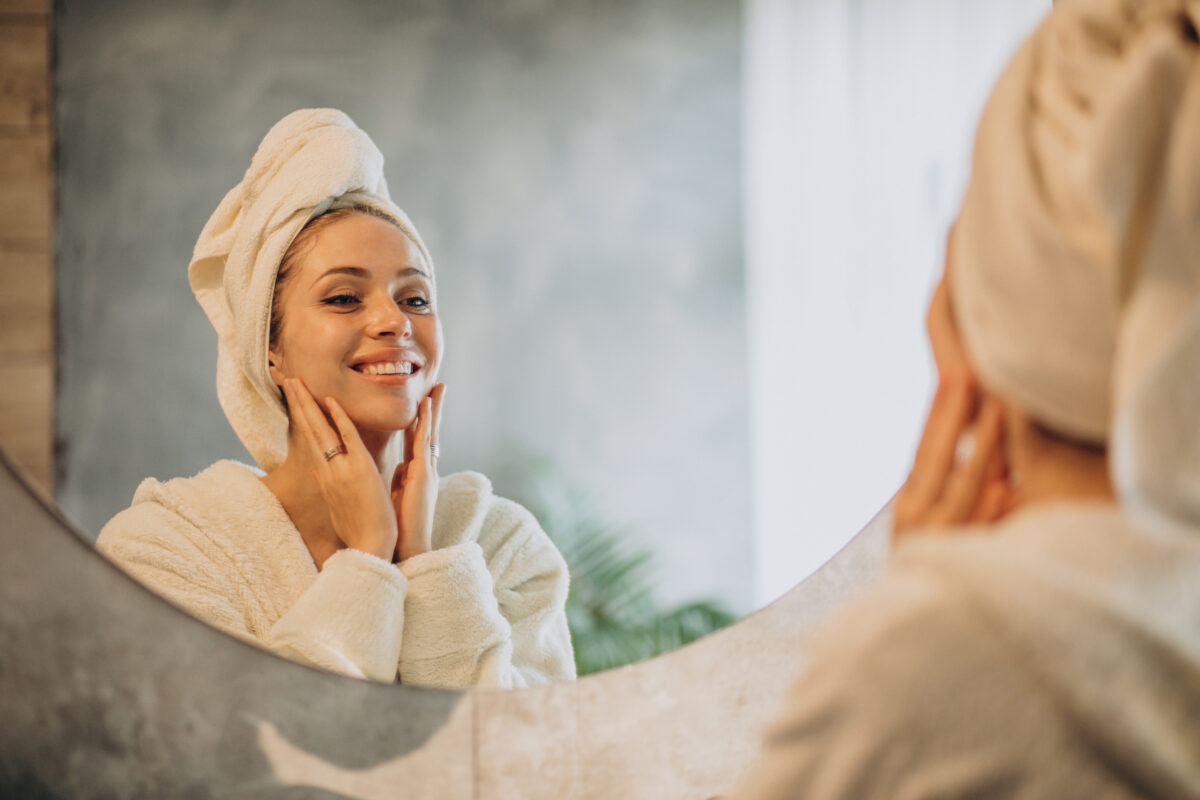- FIRST STEP
- YOU MUST DETERMINE YOUR SKIN TYPE AND ITS FEATURES (Table 1).
| NORMAL
SKIN TYPE |
DRY
SKIN TYPE |
OILY
SKIN TYPE |
|
| APPEARANCE | Radiant | Dull | Shiny |
| TEXTURE | Soft and smooth | Rough | Greasy |
| SKIN PORES | Barely visible | Almost invisible | Enlarged pores |
| GLAND SECRETION | Normoactive | Minimal active | Overactive |
| TIGHTNESS | Always | Always | Never |
| PIMPLES | Hardly ever | Never | Often |
| PRONE TO | No | Milia (white spots) | Spots and even acne |
Table 1 Characteristic features of skin types (Organized according to 1., 2., 3., and 4. references)
- SECOND STEP
- YOU SOULD CAREFULLY OBSERVE YOUR SKIN (Table 2).
|
IF YOU HAVE |
NORMAL SKIN TYPE | DRY SKIN
TYPE |
OILY SKIN
TYPE |
| · You will look a fresh, rosy color, uniform, transparency, and looks fine pores.
· Your skin has also a velvety, soft and smooth texture. |
· You skin will see dry patches or redness on the skin.
· Your skin may also feel itchy and taut. |
· Your face will look shiny all over and looks oily with enlarged pores. |
Table 2 Observation of the appearance (Organized according to 5., 6., and 7. references)
- THIRD STEP
- YOU SHOULD CARE YOUR SKIN ACCORDING TO SKIN TYPE (Table 3).
To help control oily skin, Dr. Hooper recommends the following tips:
|
TO HELP CONTROL |
DRY SKIN
TYPE |
OILY SKIN
TYPE |
| · Prevent baths and showers from making dry skin worse.
· Apply moisturizer immediately after washing. · Use an ointment or cream rather than a lotion. · Use only gentle, unscented skin care products. · |
· DO wash your face every morning and evening, and after exercise
· DO choose skin care products that are labeled “oil-free” and “noncomedogenic. · DO use a gentle, foaming face wash. · DO apply moisturizer daily. · DON’T touch your face throughout the day. |
Table 3 Basic skin care rules and tips (Organized according to 8. reference)
- FOURTH STEP
- YOU SHOULD KNOWN SOME BASIC TERMINOLOGY ABOUT COSMETICS (Table-4-5)
| WHAT ARE HUMECTANTS | · Water within a topical moisturizer formulation is an essential ingredient, but it typically contributes little to the delivery of hydration to the stratum corneum.
· In fact, water itself (regardless of soap or detergent use) is shown to be irritant to the skin under occlusion and can be associated with causing skin dryness. · Therefore, the primary hydrating effect of moisturizers is provided via humectant ingredients, which attract and hold water in the skin, either by drawing it up from the dermis to the epidermis or from the environment into the epidermis. · They can cause water to be evaporated into the environment and thus need to be used with occlusive agents to decrease or prevent more trans epidermal water loss (TEWL) |
| WHAT ARE OCCLUSIVES | · Occlusive are ingredients that sit on the skin, creating a barrier to TEWL.
· Petroleum jelly is among the best known and most widely used occlusive, shown to reduce TEWL more than 98 percent. · By contrast, other oily occlusive, which include mineral oil, silicone, and lanolin, reduce TEWL by about 20 to 30 percent. · They form a hydrophobic film between corneocytes on the skin. |
| WHAT ARE EMOLLIENTS | · It may be fair to say that “emollient” refers to the “feel” of a product, as emollients are ingredients that spread easily on the skin, helping to hold down desquamating corneocytes and fill any “gaps” between them.
· Emollients are typically oil and lipids that enhance skin texture and flexibility. · This results in a smooth skin feel, or what has been termed “skin slip” in the commercial realm, and helps make the stratum corneum soft, supple, and flexible. · Emollients may be occlusive and/or humectant or neither. · As they provide the immediate feel of moisturization, they rate high among consumers for product satisfaction. |
Table 4 Some basic terminology about cosmetics (Organized according to 9., and 10. references)
| HOW MOİSTURİZERS WORK? | · Moisturizers work in one of these three ways –
o as occlusive, o as humectants, and o as restorer of skin deficiency. · Occlusive works by creating a thin layer of protection on the skin which locks in moisture and preserve the natural good quality of the skin. · Humectants work by drawing in moisture from the environment into the skin to add hydration. · The skin may be deficient of certain nutrients and moisturizers have the capability to restore these deficiencies. |
| WHERE ARE MOİSTURİZERS USED? | · To preserve normal skin
· To improve aging skin · To protect sensitive skin · To treat skin problems |
| WHAT ARE BENEFITS OF MOISTURIZERS | · Treat and Prevent Dry Skin
· Provide Skin Protection · Reduce Therapy-associated Irritation · Prolong Benefits of Therapy · Improve Stratum Corneum Health and Function |
*Table 5 About MOİSTURİZERS (Organized according to 9., and 10. references)
- LAST STEP
- YOU SHOULD NOT USE ANY PRODUCT.
- YOU NEED TO KNOW WHAT PROPERTIES YOUR CREAM HAS (Table 6).
| FUNCTION / INDICATION | SUBSTANCES USED AS COMMON | HLC | |
| OCCLUSIVES | · Occlusive, which form a hydrophobic film to reduce the loss of water from the skin.
· This medication is used as a moisturizer to treat or prevent Xerosis, atopic dermatitis, contact dermatitis. |
1. Fatty alcohols like cetyl and stearyl alcohol
2. Wax Esters like lanolin, stearyl stearate 3. Fatty Acids like lanolin acid, stearic acid 4. Hydrocarbon Oils/ Waxes like Caprylic/capric triglyceride, mineral oil, paraffin |
We have chosen the following substances as occlusive agent in our productions;
1. Cetyl and stearyl alcohol 2. Stearyl stearate 3. Stearic acid 4. Caprylic/capric triglyceride |
| EMOLLIENTS | · Emollients, which contain lipids (fats) naturally found on the skin and smooth skin by lubricating the skin.
· This medication is used as a moisturizer to treat or prevent dry, rough, scaly, itchy skin and minor skin irritations (e.g., diaper rash, skin burns from radiation therapy).
|
1. Long chain saturated fatty acids and fatty alcohols like stearic, linoleic, linolenic, oleic, and lauric acid
2. Other lipids like fish oil, petrolatum, shea butter, and sunflower seed oil 3. Essential fatty acids like linoleic and alpha-linoleic acids |
We have chosen the following substances as emollient agent in our productions;
1. Stearic acid 2. Shea butter 3. Aloe vera barbadensıs
|
| HUMECTACTS | · Humectants, which attract and bind water from deeper layers of the skin.
· This medication is used as a moisturizer to treat or prevent ichthyosis, xerosis |
1. Diols and Triols like Propylene glycol, Butylene Glycol, Hexylene Glycol, Glycerin
2. Humectants of biological origin like Sodium PCA, Hyaluronic acid, Inositol, Panthenol 3. Ethers like Isoceteth-x, Isolaureth-x, Laneth-x, Laureth-x, Steareth-x, PEG-x (polyethylene glycol) |
We have chosen the following substances as humectant agent in our productions;
1. Glycerin 2. Panthenol 3. PEG-x (polyethylene glycol)
|
Table 6 Types of Main Ingredients in Moisturizers (Organized according to 11. reference)
REFERENCES
- http://skincare.dermis.net/content/e01aufbau/e585/index_eng.html
- https://www.webmd.com/beauty/whats-your-skin-type#1
- https://www.humbleisd.net/cms/lib2/TX01001414/Centricity/Domain/3019/Skin%20Theory%20ppt.pdf
- http://skinhelphub.com/skin-types/skin-types-and-characteristics/
- https://www.researchgate.net/publication/5300732_Understanding_and_Treating_Various_Skin_Types_The_Baumann_Skin_Type_Indicator
- http://www.bioline.org.br/pdf?dv09029
- https://link.springer.com/referenceworkentry/10.1007%2F978-3-319-32383-1_90
- http://bmctoday.net/practicaldermatologypeds/pdfs/PEDS1010_PedSkincare.pdf
- https://www.ncbi.nlm.nih.gov/pubmed/14728699
- http://emedicine.medscape.com/article/911574-treatment.
- https://www.webmd.com/drugs/2/drug-465/emollient-topical/details

